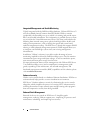
Solution Guide 5
Introduction
Dell PowerEdge servers enabled with VMware ESX Server 3i represent the
next generation of servers designed specifically for virtualization. Through its
close partnership with VMware, Dell is able to offer qualified VMware-based
virtualization solutions optimized for today’s active data centers.
With its hardware-like footprint, VMware ESX Server 3i offers a standards-
based management solution designed for reduced deployment time,
centralized management, and increased security. When coupled with energy
efficient Dell PowerEdge servers, you can also take advantage of reduced
power and cooling needs, the latest in CPU technologies, reduced server
downtime, and greater reliability.
This guide will help you understand the differences between ESX Server 3i
and ESX Server 3 versions of VMware’s Virtual Infrastructure 3 (VI3)
products as they are deployed on Dell servers, how to deploy, manage, license,
and support your solution, and Dell’s deployment best practices. A
deployment best practices checklist is also provided (see "Appendix A:
Deployment Best Practices Check List" on page 26).
NOTE: Although this guide will help you use your ESX Server 3i enabled
PowerEdge server, you are also encouraged to review the information provided by
VMware (
www.vmware.com).
VMware ESX Server 3i Features
Ease of Deployment
VMware ESX Server 3i is sold as an OEM product pre-installed on Dell
servers. Because ESX Server 3i is pre-installed, your server can be deployed
within minutes by simply connecting a keyboard, monitor, and mouse, and by
enabling basic Ethernet-based connectivity for management traffic; there is
no need to configure local storage, install ESX from CD, or configure the
server via the service console. With server data center deployments often
handled by several technicians and engineers through a formal deployment
process, eliminating these steps may save time and simplify IT deployment
flows.


















